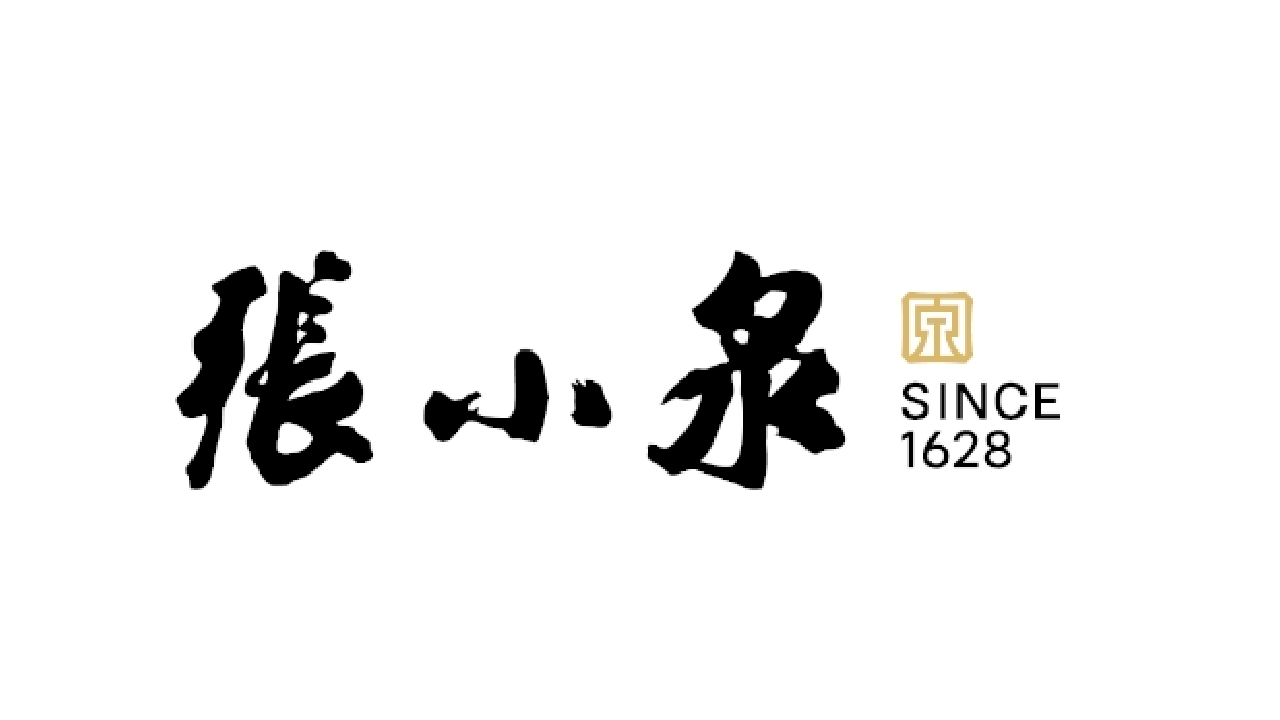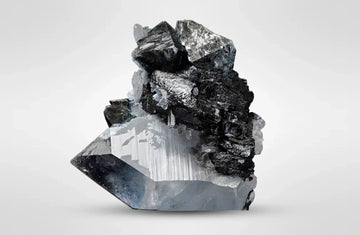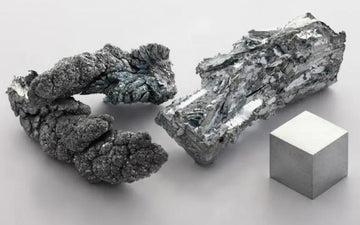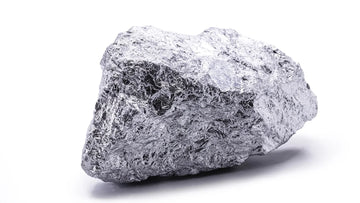In the world of kitchen knives, there's a metal called molybdenum that does important work even though we rarely talk about it. It doesn't get as much attention as carbon or chromium, but many of our favorite knives wouldn't perform as well without molybdenum. This metal helps make knives more corrosion-resistant and durable in ways that matter when you're using them daily in the kitchen.

What Is Molybdenum?
Molybdenum is a metal that looks silvery-gray, similar to other metals used in knife making. You won't find pure molybdenum in your kitchen, but small amounts of it hide inside your knife's steel. It's element number 42 on the periodic table, with a high melting point of 2,623°C (4,753°F).
This metal's remarkable heat resistance is one reason it's valuable in steel production. In kitchen knife steels, molybdenum is used as an alloying element in small amounts, typically between 0.2% and 2%. These small additions make significant differences in how the knife performs.
How Molybdenum Makes Knives Better
Enhances Corrosion Resistance
One of molybdenum's most important functions in knife steel is improving corrosion resistance, especially in stainless steel. When added to steels containing chromium, molybdenum enhances the protective passive layer that prevents rust and corrosion.

This is particularly important in kitchen environments, where knives are constantly exposed to moisture, acids from foods, and salt. Molybdenum helps knife blades resist pitting corrosion, which can be caused by these challenging conditions.
Improves Edge Retention
Molybdenum contributes to better edge retention in kitchen knives by strengthening the steel matrix and promoting the formation of hard carbides when combined with carbon. These carbides help the knife maintain its sharp edge during use.
Steels with proper molybdenum content can maintain their cutting performance longer between sharpenings, which means less maintenance and more consistent performance for home cooks and professional chefs alike.
Increases Steel Strength
Molybdenum adds strength to steel, particularly at higher temperatures. While kitchen knives don't generally operate at extreme temperatures, this property helps during the knife manufacturing process and contributes to the overall durability of the blade.
The addition of molybdenum also helps produce a finer grain structure in the steel, which contributes to both strength and edge stability.
What This Means When You're Using the Knife
Practical Corrosion Resistance
For everyday kitchen use, molybdenum's contribution to corrosion resistance means your knife is more likely to maintain its appearance and performance even when cutting acidic foods like tomatoes, citrus fruits, or vinegar-based ingredients.
While proper care is still important, molybdenum-containing steels provide an extra margin of protection against the challenging conditions of kitchen use.
Consistent Cutting Performance
Knives with appropriate molybdenum content tend to maintain their cutting performance more consistently throughout use. This means the knife behaves more predictably and requires less frequent sharpening during regular kitchen tasks.
For home cooks, this translates to a more reliable tool that performs well day after day without constant maintenance.
Sharpening Considerations
The carbides formed in steels containing molybdenum can make sharpening somewhat more challenging compared to simpler steels. Quality sharpening stones—particularly those designed for harder steels—will give the best results.
While this might mean slightly more effort during sharpening, the trade-off is longer periods between sharpening sessions due to better edge retention.
Common Kitchen Knives with Molybdenum
Many popular knife steels contain molybdenum for better performance. Let's look at some you might find when shopping for kitchen knives:
Chinese Steel Types
5Cr15MoV contains molybdenum (as indicated by the "Mo" in its name) alongside chromium (Cr) and vanadium (V). This affordable steel appears in many budget-friendly kitchen knives and offers decent corrosion resistance and edge retention for its price point.
7Cr17MoV includes molybdenum with higher carbon and chromium content than 5Cr15MoV. Found in mid-range Chinese knives, this steel offers improved performance while remaining affordable.
8Cr13MoV contains molybdenum along with carbon and chromium. Popular in affordable to mid-range kitchen knives, this "Chinese 440C" offers a good balance of corrosion resistance and edge retention.
9Cr18MoV features molybdenum alongside higher carbon and chromium content. This premium Chinese steel appears in better Chinese kitchen knives and offers enhanced performance characteristics.
10Cr15CoMoV contains molybdenum along with carbon, chromium, and cobalt. This high-end Chinese steel approaches the performance of Japanese steels while typically remaining more affordable.
Japanese Steel Types
VG-10 contains molybdenum as one of its key alloying elements alongside carbon, chromium, vanadium, and cobalt. Popular in many Shun knives and other premium Japanese cutlery, VG-10 is known for its excellent balance of corrosion resistance and edge retention.
AUS-8 includes molybdenum alongside carbon and chromium. This practical Japanese steel appears in many mid-range kitchen knives and offers good overall performance.
AUS-10 contains molybdenum with higher carbon content than AUS-8. Used in higher-end Japanese knives, AUS-10 provides better edge retention while maintaining good corrosion resistance.
ZDP-189 features molybdenum alongside high carbon and chromium content. This premium Japanese steel is known for its exceptional edge retention and is used in high-end cutlery.
Ginsan (Silver Steel #3) Available in Silver Steel #1, Silver Steel #3, contains molybdenum along with carbon and chromium. This stainless Japanese steel offers a good balance of sharpness and corrosion resistance.
White Steel (Shirogami) is a traditional Japanese high-carbon steel containing virtually no molybdenum (less than 0.05%) by design. Available in White Steel #1, White Steel #2, and White Steel #3 grades with a hardness of 60-65 HRC, it offers exceptional sharpness but minimal corrosion resistance. The absence of molybdenum creates a pure cutting experience prized by traditionalists for its responsive feel during sharpening and cutting.
Blue Steel (Aogami) is Japanese high-carbon steel containing small amounts of molybdenum (0.2-0.3%) along with chromium and tungsten. Available in Blue Steel #1, Blue Steel #2, and Blue Steel Super grades with a hardness of 61-65+ HRC, it maintains White Steel's sharp character while offering improved edge retention. The molybdenum helps stabilize the steel's complex structure, making it more durable for professional use while maintaining a traditional carbon steel experience.
German Steel Types
X50CrMoV15 contains molybdenum as indicated by the "Mo" in its name, along with carbon, chromium, and vanadium. This standard German stainless steel is used by Wüsthof, Zwilling J.A. Henckels, and many other manufacturers for its reliable performance in Western-style kitchen knives.
X55CrMoV14 includes molybdenum alongside slightly higher carbon content than X50CrMoV15. Messermeister and some other German manufacturers use this steel for its balanced properties.
1.4528 (N690) features molybdenum alongside carbon, chromium, and cobalt. This premium German/Austrian steel is used in higher-end European knives.
Cronidur 30 contains molybdenum along with nitrogen and chromium. This specialized steel was originally developed for aerospace applications and is now used in some premium German kitchen knives.
X30Cr13 is a basic stainless steel with 0.3% carbon and 13% chromium, containing virtually no molybdenum. This affordable steel reaches 51-56 HRC hardness and offers decent corrosion resistance with moderate edge retention. Common in budget kitchen knives, it provides adequate performance for casual home cooks while being easy to sharpen and maintain.
Is Molybdenum in Knives Safe?
Molybdenum in knife steel is extremely stable and safe for kitchen use. The metal stays locked in the steel's structure and doesn't migrate into food during normal cooking activities.
Interestingly, molybdenum is actually an essential trace nutrient that your body needs in small amounts, and it's found naturally in many foods like legumes and grains.
Taking Care of Molybdenum-Containing Knives
For best results with these knives:
- Wash by hand with mild soap
- Dry thoroughly after washing
- Store properly in a knife block or on a magnetic rack
- Use appropriate cutting surfaces (wood or plastic boards)
- Sharpen with quality stones suited to the hardness of your particular knife steel
Final Thoughts
Molybdenum plays an important role in modern kitchen knife steels. Its contributions to corrosion resistance, edge retention, and overall steel performance help create knives that serve well in the demanding environment of cooking.
While not as widely discussed as elements like carbon or chromium, molybdenum's presence in most quality kitchen knife steels is a testament to its value. Understanding its role can help you make more informed choices when selecting and caring for your kitchen knives.
FAQs
Is molybdenum steel good for kitchen knives?
Molybdenum isn't typically used as the primary steel type but serves as an important alloying element in many quality kitchen knives. Most good stainless steel knives contain 0.2-2% molybdenum to enhance corrosion resistance and edge stability. Steels like X50CrMoV15 (German) and VG-10 (Japanese) use molybdenum as part of their formula to achieve better performance in kitchen environments.
What is the difference between molybdenum steel and stainless steel knives?
There's no distinct category of "molybdenum steel" versus "stainless steel" knives. Molybdenum is an alloying element added to many stainless steels to improve their properties. Stainless steel requires at least 13% chromium, and many quality stainless steels also contain molybdenum to enhance corrosion resistance and performance. When you see "Mo" in a steel name (like X50CrMoV15), it indicates molybdenum is present in the alloy.
Is molybdenum good for knife blades?
Yes, molybdenum is beneficial for knife blades as an alloying element. It enhances corrosion resistance, contributes to better edge retention, and improves the overall stability of the steel. Most premium kitchen knife steels contain molybdenum for these benefits, which is why it appear in many steel designations like MoV (molybdenum-vanadium) steels.
Is molybdenum better than vanadium in kitchen knives?
Molybdenum and vanadium serve different complementary purposes in knife steel rather than being alternatives to each other. Molybdenum primarily enhances corrosion resistance and overall steel strength, while vanadium focuses on improving hardness and wear resistance. Many high-quality knife steels contain both elements for their combined benefits. Neither is inherently "better" than the other—they perform different functions in the steel.
What are the disadvantages of molybdenum in knife steel?
While molybdenum offers several benefits, its main limitation is that it can make sharpening somewhat more challenging, especially in steels with higher molybdenum content. The harder carbides formed can be more difficult to grind during sharpening. Additionally, molybdenum slightly increases manufacturing costs, which can raise knife prices. However, these disadvantages are generally outweighed by the performance benefits molybdenum provides.
How much molybdenum do Japanese kitchen knives contain?
Japanese kitchen knives typically contain varying amounts of molybdenum depending on the steel type. Popular Japanese stainless steels like VG-10 and AUS-10 contain approximately 0.9-1.5% molybdenum. Traditional carbon steels like White Steel (Shirogami) contain virtually no molybdenum, while Blue Steel (Aogami) may contain small amounts. The specific molybdenum content is carefully balanced with other elements to achieve the desired performance characteristics.
Does molybdenum content affect knife sharpening?
Yes, molybdenum can affect the sharpening process. Steels with higher molybdenum content typically form harder carbides that can be more challenging to abrade during sharpening. Quality sharpening stones, particularly those designed for harder steels, give better results. While this might require slightly more effort during sharpening, the trade-off is generally longer edge retention, which means less frequent sharpening overall.
Can molybdenum in kitchen knives prevent rust?
Molybdenum enhances rust prevention when combined with chromium in stainless steel but doesn't prevent rust by itself. It works by strengthening the passive protective layer that forms on stainless steel, making it more resistant to breaking down when exposed to acidic foods or moisture. Knives with both chromium and molybdenum show better corrosion resistance than those with only chromium. However, proper care remains important for maintaining a knife's appearance and performance.
Which kitchen tasks benefit most from molybdenum in knife steel?
Kitchen tasks involving acidic foods benefit most from molybdenum in knife steel. Cutting tomatoes, citrus fruits, vinegar-based marinades, and fermented foods can challenge lesser steels, potentially causing pitting and staining. The enhanced corrosion resistance from molybdenum helps prevent these issues. Additionally, knives used for extended food preparation sessions benefit from molybdenum's contribution to overall steel stability and edge retention.
What kitchen knife steel has the highest molybdenum content?
Among common kitchen knife steels, specialized powder metallurgy steels like CPM S30V and CPM S35VN contain some of the highest molybdenum contents at approximately 2%. More typical kitchen knife steels like X50CrMoV15, VG-10, and AUS-10 typically contain between 0.5-1.5% molybdenum. Beyond certain percentages, additional molybdenum doesn't provide proportional benefits and can make manufacturing more difficult, which is why most kitchen knife steels stay within these ranges.





